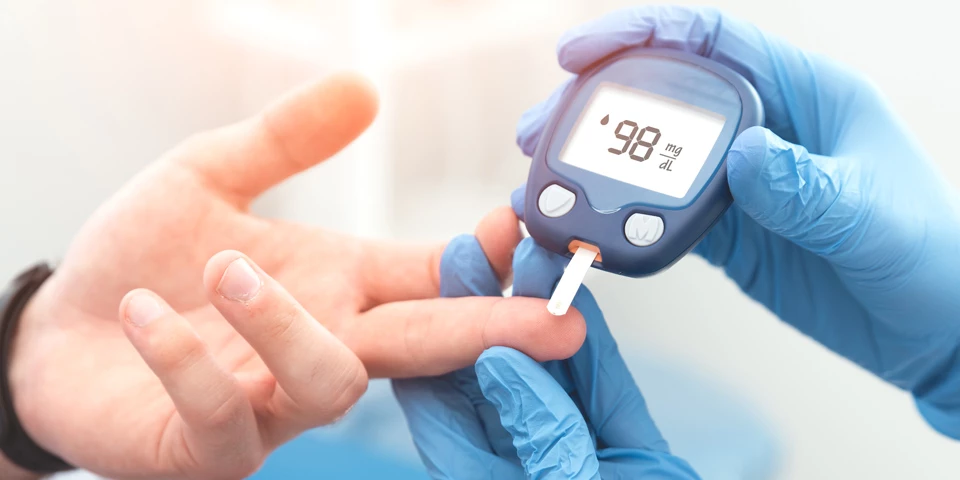Have you ever tested your blood sugar levels? It might be something that you’ve been meaning to do but never got round to. Home testing kits for blood glucose are making it easier for people to take control of their health. In this blog, we explore how these kits work and whether they can really diagnose diabetes.
What is diabetes?
Diabetes is a lifelong condition that can have serious complications, if it’s not treated early enough. It’s caused by a problem with the hormone (insulin) that breaks down sugar and turns it into energy – people with diabetes have high blood sugar levels.
There are two types of diabetes:
Type 1 diabetes – this is where the body’s immune system attacks and destroys the cells responsible for producing insulin
Type 2 diabetes – this type of diabetes occurs when the body doesn’t produce enough insulin or doesn’t process it properly
According to Diabetes UK, 5.5 million people in the UK will have diabetes by the year 2030.¹ Type 2 diabetes is the most common – 90% of adults with diabetes have type 2.
Many people have diabetes and don’t realise. The symptoms are often very general, and in type 2 diabetes they progress slowly. The main symptoms are:
- Feeling very thirsty
- Urinating more often, especially at night
- Feeling tired
- Blurred vision
- Weight fluctuations
- Frequent thrush or itching around the penis or vagina
- Wounds that aren’t healing
Diabetes during pregnancy is common. It’s known as gestational diabetes, and it occurs when the placenta releases hormones that stop insulin from doing its job properly.
When should you get tested?
The only way of knowing for sure if you have diabetes is with a test.
If you are in a high-risk group, then you should test your blood sugar levels frequently. You are at greater risk of developing type 2 diabetes if:
- You have a family member with diabetes
- You are over 40 years old
- You are overweight and have a large waist measurement
We also recommend getting tested if you have a poor diet, you don’t exercise, or you have other medical conditions, such as high cholesterol. Diabetes can increase your risk of arteriosclerosis (clogging or hardening of the arteries), if you have high cholesterol.
How do you test for diabetes?
If you think you have the symptoms of diabetes, then your GP can arrange for a urine test and/or a blood test. The samples will be sent away, and you’ll usually have to wait a few days to discuss the results with your doctor.
Some people prefer the convenience of a home testing kit, that they can use when it suits them. Self-kits are a practical solution for anyone in the high-risk group, who needs a test to check their blood sugar frequently. These kits are:
- Simple to use
- Fast – results in minutes
- Reliable and convenient
There are lots of kits available to buy on the market that have been medically reviewed, but one of the most popular is the SELFCheck blood glucose test.
Using a blood glucose home test kit
Home test kits use a test strip and a prick of blood from your finger to give you a blood sugar reading. The kit can detect blood glucose (sugar) ranging from 1 to 55 mmol/l.
In healthy people, your blood sugar level normally stays within a narrow range, only raising slightly after a meal or dipping in the morning before you’ve eaten. However, in people with diabetes, blood sugar levels can alter wildly throughout the day.
The SELFCheck blood glucose test contains the following:
- 2 x test strips
- 2 x lancets (small, stubby needle)
- 2 x colour charts
- Information leaflet
For the best results, you should perform the test first thing in the morning on an empty stomach – do not eat or drink in the 12 hours before.

Make sure you have clean hands and a dry sampling area, before you open the kit. Then use the lancet to prick your finger and gently squeeze a drop of blood onto the test strip. You can then use the colour charts to read your results.
A normal blood sugar reading is anywhere between 4 and 7.8mmol/l. If your results are outside of this, then you should speak to your doctor.
A home blood testing kit alone cannot determine whether you have diabetes, but an abnormal result is a good prompt to start a discussion with your GP.
Next steps – managing diabetes
If your reading isn’t within the normal range, then see your doctor. They can investigate further with an oral glucose tolerance test or a HbA1c (glycated haemoglobin) test.
If you are diagnosed with type 2 diabetes, then you might be offered medicine to help control your blood sugar levels. There are different types of medication available, and your GP will work with you to find one that suits you.
Some simple changes to your lifestyle can make a big difference. To help control your blood sugar levels, we recommend that you:
- Lose weight (if required)
- Eat a diet rich in fruit and vegetables
- Reduce the amount of sugar, fat, and salt you eat
- Don’t skip meals – eat breakfast, lunch, and dinner every day
- Increase your physical exercise to 2.5 hours a week
Losing weight is only necessary if you are overweight or obese, and it’s not suitable for all diabetics. Before you start to cut down your calories, seek medical advice. Losing weight slowly can help lower your blood sugar, blood pressure, and cholesterol.
The complications of diabetes
Left untreated diabetes can cause serious complications, including nerve damage, cardiovascular diseases, and circulatory problems. This can result in:
- Limb amputations
- A stroke
- Vision and hearing loss
- Erectile dysfunction
- Kidney failure
- Chronic headaches
- Wounds that take a long time to heal
Complications such as these can be life-altering, which is why it’s so vital that you are regularly tested for diabetes, if you are in a high-risk group.
Blood glucose meters vs. home test kits
The SELFCheck home testing kit is designed to be used by people who think they may have diabetes and want to check their blood sugar level. It’s not intended to be used by people already living with diabetes, who need continuous glucose monitoring.
There are a wide variety of glucose monitors on the market, from compact systems that come with lancets and test strips to continuous glucose monitors (CGM) that you wear on your arm. If you’ve recently been diagnosed with diabetes, ask your diabetic nurse or GP for additional information.
The key takeaway
Diabetes is a lifelong condition, that can cause serious complications if left untreated
Early detection is key to treating it successfully. If you’re in a risk group for diabetes, then checking your blood sugar should be something you do regularly.
Home testing kits are a fast and reliable way to measure blood glucose levels without having to leave the comfort of your home. They can’t diagnose diabetes, but an abnormal reading could be the prompt you need to start a conversation with your GP.





